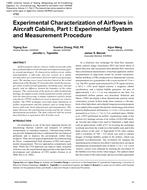Description
Airflow patterns and air velocity within an aircraft cabin have profound effects on the thermal environment and air quality around passengers. To characterize airflows in air cabins experimentally, a full-scale, five-row section of a jumbo aircraft cabin was constructed. Each row had seven passenger seats. The mockup was a wood structure based on the actual dimensions of the Boeing 767 aircraft cabin. Inside the passenger cabin, actual aircraft equipment, including seats, internal panels, and air diffusers, formed the boundary of the cabin airspace. The construction of the mock air cabin included the fuselage, air supply system, a data acquisition system, and software for data processing. A unique volumetric particle streak velocimetry (VPSV) method was used to measure air velocity profiles. The VPSV technique overcomes many limitations in airflow measurement and has features such as being nonintrusive, full-scale, three-dimensional, and instantaneous. This paper discusses the experimental systems and the air velocity measurement procedures. The data collected with the system described here is reported in Part II of this work.
Citation: ASHRAE Trans. vol. 111, pt. 2, paper no. 4789, p. 45-52, Denver 2005
Product Details
- Published:
- 2005
- File Size:
- 1 file , 4.9 MB
- Product Code(s):
- D-26988




